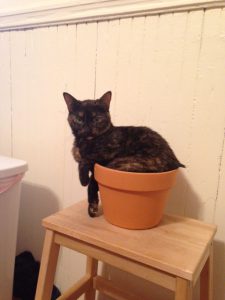
Perhaps you already know this, but out there in the World Wide Web there are many websites devoted to helping people discover their pet’s ancestral DNA.
With the technological advances in DNA testing, humans have started to use it more and more to help understand better where they come from and, especially from a genealogical stand point, to help supplement or sometimes define their ancestral research.
So why not do the same for your pet?
I have a cat. Her name is Coco and she was found at 8 weeks old, back in July of 2012, wandering the streets of downtown Los Angeles with her “brother.” (I put that in quotation marks because how can you really tell with cats and dogs?)
At 12 weeks, I adopted her as my own.
But where did she come from? What is her breed or heritage? The company I adopted her from guessed she was some type of tortoiseshell cat, a very common breed here in America and almost exclusively female. It is basically a nice way of describing a multi-colored, unidentifiable cat.

So I decided to investigate the world of animal DNA testing, looking for whatever information would or could be found, especially for a little mutt like Coco. I started by asking various members of the Research Services staff to see if any of them had done their pet’s DNA. Sheilagh Doerfler, Senior Researcher, had had her dog Sable tested a few years back.
Sable’s results were that she was a Dalmatian/Rottweiler mix. They had used a system of algorithms to predict the most likely combination of pure and/or mix breed dogs in the last three generations from Sable that best fit her DNA marker pattern. They also went on to identify what breeds may have mixed in the past generations to help get a better idea of Sable’s breed ancestry (Anatolian Shepherd Dog, Norwegian Elkhound, Labrador Retriever, etc.). As there are so many dog breeds (currently 340 are recognized by the Fédération Cynologique Internationale, the world governing body of dog breeds), and so many dogs intermix, sometimes the genetic make-up cannot be traced.

Another example is Larry Stooges.[1] Larry’s parents had his DNA tested, and it came back that Larry was a Beagle/Labrador Retriever mix. The testers provided the additional information that, since Larry is still a puppy, he was likely to grow to 34–56 pounds. This was predicted using his ancestry, genetic markers, and the fact he is a neutered male.
For cat DNA, it is much easier to determine their breed if they are derived from one of the 29 “fancy cat” United States breeds. The heritage of cats outside of the United States becomes more difficult to trace, as their history and breeding strategies differ. Cats were first domesticated in Egypt 4,000 or so years ago. They were mostly used as hunters or to help protect the food storage from vermin and pests. They were worshiped as Gods, and my Coco definitely believes she is descended from one of these early cats.
The process of identifying cat DNA is as such:
- Obtain cotton pipe cleaner from desired DNA testing facility:
Here are just a few of the many sites and labs that offer animal DNA tests
https://www.vgl.ucdavis.edu/services/CatandDogDNATyping.php)
- Attempt to have animal sit for a period of time long enough to open its mouth and obtain sample. From experience, this is rather difficult and most likely involves the presence of treats.
- Send it off!
- The lab will then take your pet’s swab and test it for specific markers (single nucleotide polymorphisms – a variation in a single base pair in a DNA sequence).
- They then compare this genetic profile to a database of cat profiles that has been compiled from around the world.
- After determining the cat’s origin, the lab then looks at its genetic makeup to establish likeness to the 29 most common breeds (around 60 cat breeds are known). Just as with dogs, families of breeds share many characteristics when it comes to genetic mutations (aka phenotypic traits), such as fur color and length.
Then – you are presented with your cat’s DNA ancestry! But the labs note:
“A true random bred cat will not match to specific breeds and low match probabilities will not be reported” – Lyons’ Feline Genetics Laboratory at the University of California
So unless your cat comes from two distinct breed parents or grandparents, the probability of detecting your cat’s breed is basically zero.
When I told Coco the sad news, she walked away to sit in her favorite spot above the refrigerator; clearly she hasn’t been bit by the genealogical bug yet.
So if you are interested in DNA analysis for yourself or your pet, it is a great way to see the science behind the records and can be extremely informative and sometimes surprising!
Also, in case all you Yak and Alpaca owners were wondering, many places can test parentage and genetic diseases for them, too.
Note
[1] He is Lindsay Fulton’s brother’s dog; Lindsay is Director of Research Services at NEHGS.
So typical of a cat to be unconcerned about anything that might matter to us! She is a fine pet though and she is lucky to have you. Nice post!
Love your post! What a cool idea, although I think I’ll have my own DNA tested before my dog’s.
Very interesting and well written Mollie!
Mollie,
What an interesting post! I never thought of getting DNA on my 20 year old calico cat. Before her, I had three litter-mate rescue cats. When I took them to the vet the first time at about 5 months, she told me they probably had different fathers. The mother had some Manx, judging by a stump of a tail which clearly wasn’t cut off. All the kittens had slightly different tails, from none to a full tail. When I asked the vet why she thought they had multiple fathers, she said they had very different face shapes and body shapes. She also said that as many males as possible will mate with a female in heat. The mother was a feral cat, who always had her kittens in the same garage, but hadn’t yet been caught by the rescue group. The litter after this, they finally caught her, which was how they verified the Manx tail. Finally, they had her spayed.
Had I done DNA on the kittens, we could have checked out the vet’s supposition. The only male died of kidney disease at age 5, and the females tested positive for it. This was probably also genetic at that age. Both lived to past 16 on a special diet. The calico came to me at age 12 after having lived with the same person until then. What would I learn from doing DNA on her? All I know about her background is that she came from a farm. She now has multiple medical problems, but the (different) vet says all her issues are normal at her age. The vet also says that while calico is not really a breed, she’s only seen one male.
Thanks for your article about a different kind of genealogy!
Doris
Most interesting! We have two 4 month olds, one a tortie w/ a short flat coat, her sister a calico w/ much longer, softer fur, a curled tail, and hind legs longer than the front. Never saw this tail before, but somebody started breeding for this “American Ringtail” type a few years ago. Kinda wish the Shelter hadn’t spayed her! Named after 2 great ladies: Molly (Ivins) and (Dame) Maggie (Smith). My ability to find 4 leaf clovers, and for stray cats to find me, is inherited from my grandmother Merry Eliza Decker Sherwood, and the best photo of my father Eben is one of him holding a tiny kitten. Being nutty for cats is genetic!